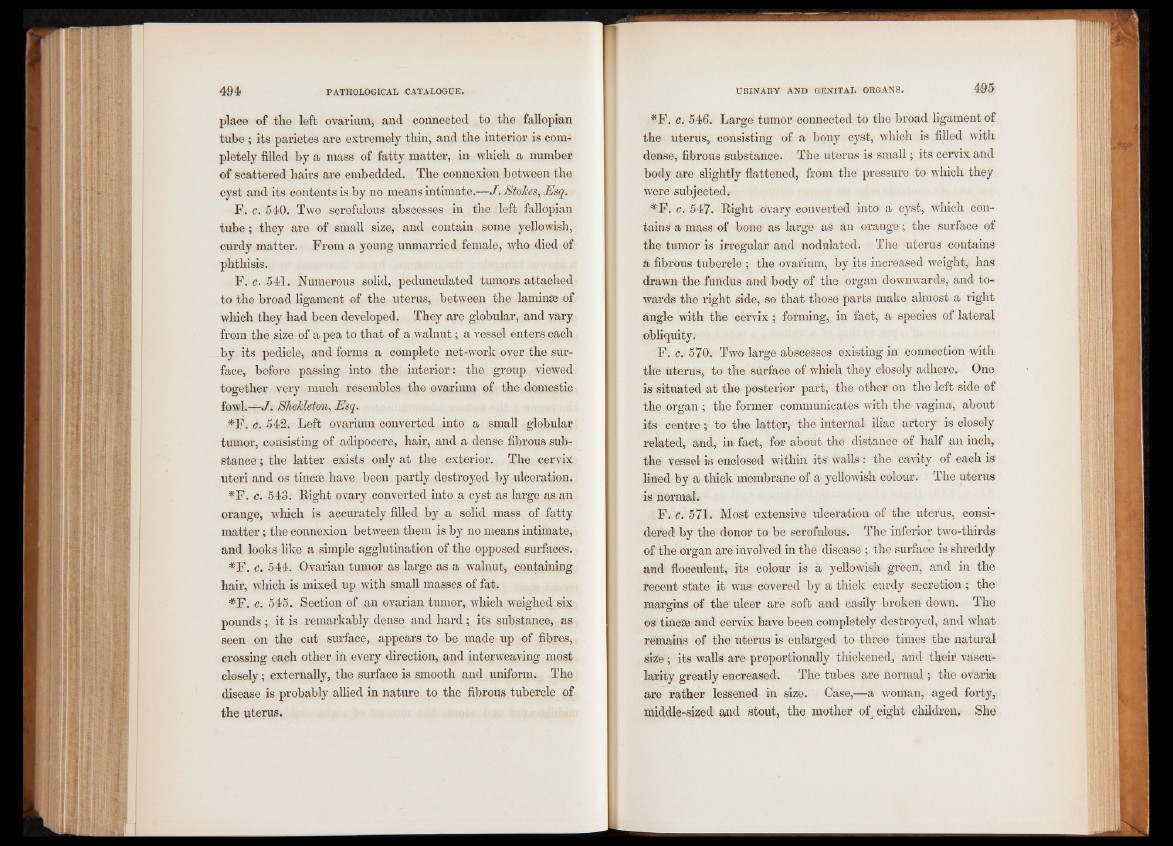
place of the left ovarium, and connected to the fallopian
tube; its parietes are extremely thin, and the interior is completely
filled by a mass of fatty matter, in which a number
of scattered hairs are embedded. The connexion between the
cyst and its contents is by no means intimate.—J . Stokes, Esq.
F. c. 540. Two scrofulous abscesses in the left fallopian
tube; they are of small size, and contain some yellowish,
curdy matter. From a young unmarried female, who died of
phthisis.
F. c. 541. Numerous solid, pedunculated tumors attached
to the broad ligament of the uterus, between the laminae of
which they had been developed. They are globular, and vary
from the size of a pea to that of a walnut; a vessel enters each
by its pedicle, and forms a complete net-work over the surface,
before passing into the interior: the group viewed
together very much resembles the ovarium of the domestic
fowl.—J. SheJcleton, Esq.
*F. c. 542. Left ovarium converted into a small globular
tumor, consisting of adipocere, hair, and a dense fibrous substance
; the latter exists only at the exterior. The cervix
uteri and os tincse have been partly destroyed by ulceration.
*F. c. 543. Right ovary converted into a cyst as large as an
orange, which is accurately filled by a solid mass of fatty
matter; the connexion between them is by no means intimate,
and looks like a simple agglutination of the opposed surfaces.
#F. c. 544. Ovarian tumor as large as a walnut, containing
hair, which is mixed up with small masses of fat.
#F. c. 545. Section of an ovarian tumor, which weighed six
pounds; it is remarkably dense and hard; its substance, as
seen on the cut surface, appears to be made up of fibres,
crossing each other in every direction, and interweaving most
closely; externally, the surface is smooth and uniform. The
disease is probably allied in nature to the fibrous tubercle of
the uterus.
*F. o. 546, Large tumor connected to the broad ligament of
the uterus, consisting of a bony cyst, which is filled with
dense, fibrous substance. The uterus is small; its cervix and
body are slightly flattened, from the pressure to which they
were subjected.
^F. c. 547. Right ovary converted into a cyst, which contains
a mass of bone as large as an orange; the surface of
the tumor is irregular and nodulated. The uterus contains
a fibrous tubercle ; the ovarium, by its increased weight, has
drawn the fundus and body of the organ downwards, and towards
the right side, so that those parts make almost a right
angle with the cervix; forming, in fact, a species of lateral
obliquity.
F. c. 570. Two large abscesses existing in connection with
the uterus, to the surface of which they closely adhere. One
is situated at the posterior part, the other on the left side of
the organ ; the former communicates with the vagina, about
its centre; to the latter, the internal iliac artery is closely
related, and, in fact, for about the distance of half an inch,
the Vessel is enclosed within its walls : the cavity of each is
lined by a thick membrane of a yellowish colour. The uterus
is normal.
F. e. 571. Most extensive ulceration of the uterus, considered
by the donor to be scrofulous. The inferior two-thirds
of the organ are involved in the disease ; the surface is shreddy
and flocculent, its colour is a yellowish green, and in the
recent state if was covered by a thick curdy secretion ; the
margins of the ulcer are soft and easily broken down. The
os tincse and cervix have been completely destroyed, and what
remains of the uterus is enlarged to three times the natural
size; its walls are proportionally thickened, and their vascularity
greatly encreased. The tubes are normal; the ovaria
are rather lessened in size. Case,—a woman, aged forty,
middle-sized and stout, the mother of eight children. She